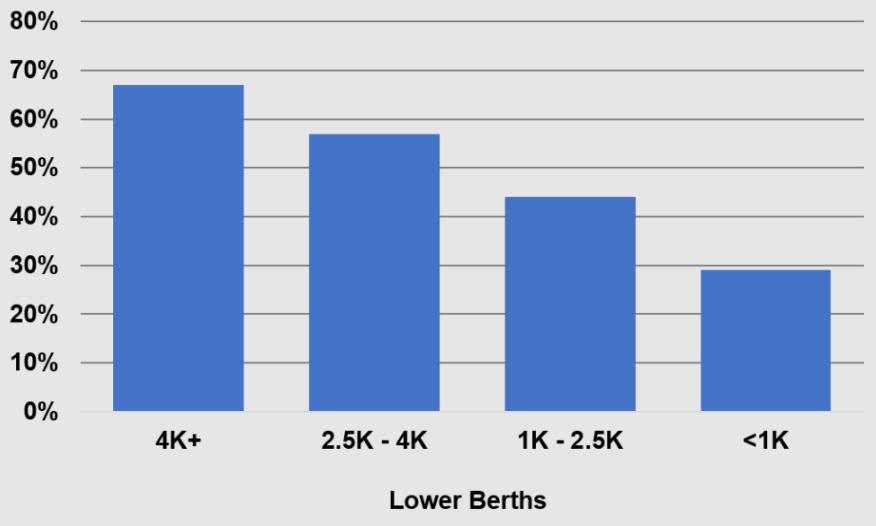Nassau Cruise Port Global
BA’s design for the waterfront features a completely transformed Port and Welcome Center, additional mega berths to accommodate the largest cruise ships in the world...
Gain deeper insights into the maritime industry with detailed updates on key developments and trends, meticulously curated by our team of specialists.

In BA’s previous bulletins, we outlined the cruise industry’s push toward decarbonization, the exploration of alternative fuel options, and how ports will play a significant part in this transition.
One key technology and noteworthy initiative is the adoption of Shore Side Electricity (SSE) or shore power. This technology allows cruise ships to plug into the local power grid while docked, eliminating local emissions from ships while they are in port. According to CLIA, the ability to connect to SSE can cut a cruise vessel’s overall CO2 emissions between 6% and 10%.
There are a few guiding principles that a port needs to review before moving forward for such an investment:
At the other end of the plug, comes the ships, and their ability to connect to a shore power source.
As such, an increasing trend today is that more and more cruise ships are being built or retrofitted with shore power capabilities. As the maritime world sets sail towards a greener future, this bulletin explores the trends in the adoption of SSE among the global cruise fleet, and how SSE is making waves in the cruise industry.
Here is a snapshot of where the cruise fleet is today:
First, BA looked at the global fleet overall, including those ships currently on order, to see the breakdown of ships that have, or will have shore power.
When assessing the global cruise fleet, including ships on order, 42% have adopted shore power, while 58% have yet to implement this sustainable technology. This highlights ample room for growth in shore side electricity adoption.
Considering the distribution by the number of lower berths, 56% of total lower berths on cruise ships have access to shore power, while 44% do not. This balanced distribution demonstrates that larger vessels are adopting shore power at a faster pace.

Next, BA examined how SSE adoption correlates with a cruise ship’s age. The data reveals a clear trend – newer vessels are more likely to have SSE capabilities. Ships in the “New Build” category, representing vessels set to enter the global fleet, lead the way with an impressive 68% of new builds on order being equipped with SSE technology. For ships aged under 10 years, SSE adoption remains high at 54% of those ships having shore power capabilities.
As ships continue to age, the percentage of those equipped with SSE naturally decreases. For ships under 20 years old, the adoption rate drops to 40%, while ships under 30 years old are at 38%. Notably, ships over 30 years old, while representing a small portion of the fleet at just 5%. This shows that at these older ages, SSE is a feasible retrofit option for older vessels.

Size, it seems, does matter when it comes to SSE adoption. There is a correlation with ship size based on the number of lower berths.
Ships with more than 4,000 lower berths lead the pack in SSE adoption, with an impressive 67% of them equipped with SSE technology. Following closely behind are ships between 2,500 and 4,000 lower berths, with 57% of them embracing SSE technology. Medium (1,000 to 2,500 lower berths) and small ships (less than 1,000 lower berths) have SSE adoption rates of 44% and 29%, respectively.
SSE adoption across different ship sizes highlights that cruise companies recognize the importance of reducing their environmental impact, regardless of their vessel’s capacity.

When examining which cruise corporations are at the forefront of SSE adoption, some clear leaders emerge. Carnival Corporation, one of the industry’s giants, leads the way with ~60 of its ships, or more than 60% of its fleet, equipped with SSE technology. Following closely behind is MSC Cruises, with 20 of its ships, or just over 65% of its fleet embracing the green initiative. Similarly, NCLH has also made significant strides with ~50% of its fleet equipped with SSE.
The commitment to sustainability extends beyond the well-known giants, with smaller companies like Hurtigruten, Virgin, Ponant, Mystic, Viking, Azamara and Disney all surpassing the 50% mark in SSE adoption. Hurtigruten, Virgin, Mystic, Viking, Disney and Azamara deserve special mention, with all or nearly all their ships equipped with SSE technology.
While operators continue to retrofit existing vessels, withdraw older vessels, or construct new vessels, these numbers will continue to change, though the increasing trend will prevail. This drive is not only coming from the industry’s pursuit of net-zero carbon operations by 2050, but regulations coming online today that mandate and necessitate the need for shore power.
Shore power mandates are already in place in regions like California, with the EU’s new Fit for 55 legislation requiring that all cruise ships use shore power for their electricity needs while moored at major EU ports by 2030. Shore power will help ships adhere to other regulations coming online, such as the CII, in reducing their overall CO2 emissions. These requirements — and future requirements — are and will fundamentally change the way ports need to operate, compelling them to invest in the necessary infrastructure to support the industry’s transformation.
The journey toward sustainability in the cruise industry is far from a solitary endeavor carried out by individual operators. Rather, it is a comprehensive transformation that involves all stakeholders, including ports, regulatory bodies, and the broader maritime ecosystem. As these various entities collaboratively invest in greener infrastructure, adopt energy-efficient technologies, and adapt to ever-evolving environmental regulations, the industry is poised to navigate towards a more sustainable and eco-conscious future. This not only benefits the cruise sector but also contributes to global sustainability efforts, setting a precedent for other industries to follow.